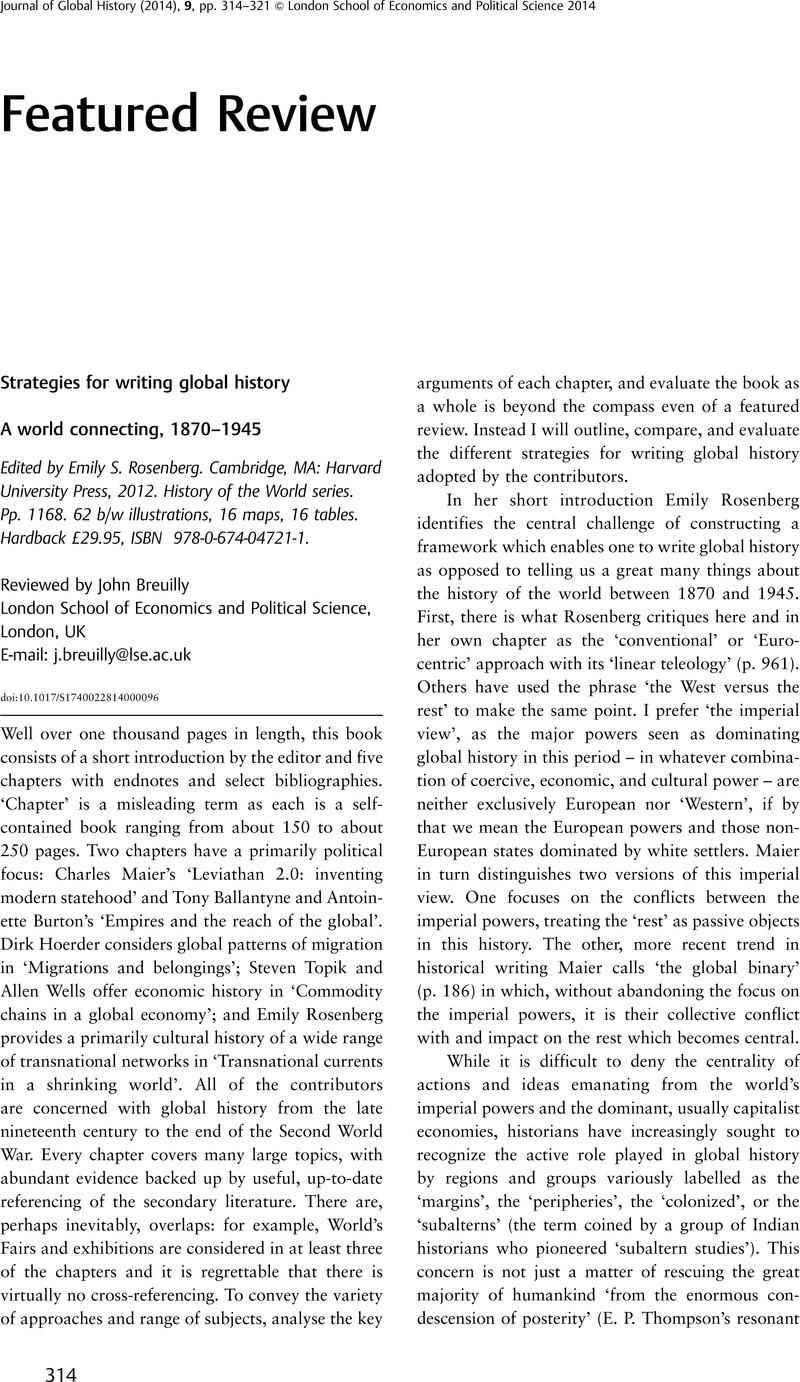No CrossRef data available.
Article contents
Strategies for writing global history - A world connecting, 1870–1945 Edited by Emily S. Rosenberg. Cambridge, MA: Harvard University Press, 2012. History of the World series. Pp. 1168. 62 b/w illustrations, 16 maps, 16 tables. Hardback £29.95, ISBN 978-0-674-04721-1.
Published online by Cambridge University Press: 23 May 2014
Abstract

- Type
- Featured Review
- Information
- Copyright
- Copyright © Cambridge University Press 2014
References
1 For example, his chapter ‘Transformations of territoriality, 1600–2000’, in G. Budde, S. Conrad, and O. Janz, eds., Transnationale Geschichte: Themen, Tendenzen und Theorien, Göttingen: Vandenhoeck & Ruprecht, 2005, pp. 32–55.
2 A key argument in Herbst, Jeffrey, States and power in Africa: comparative lessons in authority and control, Princeton, NJ: Princeton University Press, 2000Google Scholar.
3 A problem in Foucault's notion of governmentality is that it claims to unmask the forms of power hidden in liberal state practices. However, these had barely penetrated popular culture, values and practices before 1914 and, when state practices did do this extensively, they took often overtly illiberal and explicit forms of unfreedom.
4 Hochstadt, Steve, Mobility and modernity: migration in Germany, 1820–1989, Ann Arbor, MI: University of Michigan Press, 1999CrossRefGoogle Scholar. Those more elaborate and reflective sources are also likely to be the work of extraordinary rather than representative individuals.
5 Dikotter, Frank, The age of openness: China before Mao, Hong Kong: Hong Kong University Press, 2008Google Scholar.
6 See Peter van der Veer, `Nationalism and Religion’, in John Breuilly (ed), The Oxford Handbook of the History of Nationalism (Oxford, 2013), pp. 655–671.
7 In the second edition of Anderson, Benedict, Imagined communities: reflections on the origins and spread of nationalism, London: Verso, 1991Google Scholar, Anderson adds a new section on maps, museums, and censuses as characteristically modern state practices.
8 The pioneering work was Gallagher, John and Robinson, Ronald, Africa and the Victorians, London: Macmillan, 1961Google Scholar.
9 One example from a growing literature is Aydin, Cemil, ‘Pan-nationalism of pan-Islamic, pan-Asian, and pan-African thought’, in John Breuilly, ed., The Oxford Handbook of the History of Nationalism, Oxford: Oxford University Press, 2013, pp. 672–693Google Scholar.
10 Christopher Bayly, The birth of the modern world, 1780–1914, Oxford: Blackwell, 200Google Scholar. On period concepts such as early modernity used globally, see, for example,
Chakrabarty, Dipesh, ‘The muddle of modernity’, American Historical Review, 116, 3, 2011, pp. 663–675CrossRefGoogle Scholar. Jürgen Osterhammel's massive study, Die Verwandlung der Welt: eine Geschichte des 19. Jahrhunderts, Munich: C.H. Beck, 2009, is, I understand, due to be published in English translation in a later volume in the History of the World series.




